Elder Tree, Elderflower and Elderberry Identification, Edibility and Distribution
Elder – Sambuca negris
Also sometimes known as bourtree in Scotland and Ireland
And elderberry I have learned to call it.
I love its blooms like saucers brimmed with meal,
Its berries a swart caviar of shot,
A buoyant spawn, a light bruised out of purple.
Elderberry? It is shires dreaming wine.Seamus Heaney
Glanmore Sonnets
- Edibility – 4/5 – flowers, 5/5 – berries. Elder berries should not be consumed raw as they contain a cyanogenic glycoside called sambunigrin which can be harmful in high dosage. Cyanogenic glycosides are found in the seeds of numerous other fruits too, including apples and peaches, so we are at the “safe in appropriate dosage and with proper preparation” end of the spectrum of edibility here. Sambunigrin consist of a cyanide group bonded to a sugar; when the compound is digested, the cyanide group is freed from the sugar, and can exert toxic effects. Its hard to say what a safe dosage is, as it depends on the plant you are harvesting from (stage of growth, specific phytochemistry from its specific location) and the person consuming (age, personal biochemistry etc). Suffice to say that friend of mine who made raw elderberry smoothies for his whole family had spectacular purple vomit to clean up from 3 out of 4 of them! I have another friend who (against my advice) allows her kids to nibble a few raw elderberries here and there, with no ill effects. Fortunately sambunigrin is volatile, evaporating at around 27˚C, so boiling elderberries during preparation renders them perfectly safe. Elderflowers contain only trace quantities of the compound, so are safe for cold infusion, tinctures etc. The leaves, stems and berries of elder can also contain other alkaloid compounds (notably sambucine) which are also poisonous. Twigs and foliage should be removed as far as practicable, but it would take a patient person to remove every last bit of twig, and a small bit of twiggage is inevitable and not a big issue. Only you can decide what you are comfortable with, and how much time and effort you want to spend removing every tiny bit of twig!
- Recipes: elderflower champagne, elderberry vinega, fruit leathers
- Identification – 4/5 – beware of carrot family umbelifers, some of which are very toxic, but none of which are woody trunked small trees/large bushes. Can also be confused with wayfaring and rowan trees, which would lead to little more than disappointment.
- Distribution – 5/5 – Very common
- Season – Flowers May – July, Berries August – November
- Habitat – fertile ground, hedgerows, parkland, roadsides, often near human settlement
Elderflowers
Elderflowers are one of natures finest edible treasures and for me, the signature wild food of early summer. Their elegant, sweet, heady fragrance translates into lots of delicious drinks and desserts. Occasionally, this delightful scent can develop from muscat bananas through musky to cat pee, the result of . You should be able to avoid this if you harvest them on dry, bright, sunny mornings. Blossoms harvested in these conditions will also carry many more natural yeasts, which are useful if you are planning to make wine or champagne with them. Elderflower champagne is one of the simplest and most rewarding boozy summer preparations.
Elder is a common low-growing large shrub/small tree that produces a near blanket of creamy-white umbeliferous flower heads from mid may to July, so you should not find them hard to come by. Do be sure that you are picking them from a substantial woody-stemmed plant or you could be harvesting a member of the carrot family which all have superficially similar umbels of white flowers. It is this and a passing similarity in leaf shape (pointed ovals with a serrated edge growing from a central stem) that got ground elder its name. This is a painless error as ground elder is edible, but you may be disappointed at how your wine turns out!
The gnarled and lichen-laden trunks of elder are a key feature that differentiates them from rowan and wayfaring trees which also have sprays of off-white flowers. I suspect that these tormented trunks are largely responsible for the wealth of folklore associated with elder. Like many such traditions, some of the myths at first seem contradictory, but on reflection can be seen as different types of reverence. For example, elder was widely refered to as ‘The Witch’s Tree’ and to hang a cradle from its boughs would invite her wrath. Nevertheless, it was considered bad luck not to have one near your house. On no account should you burn elder if you are of a superstitious nature as this will surely curse you for eternity. If, like me, you lean more towards bushcraft, perhaps you might risk it as the hollow stems flare up nicely. Its this that got elder its name – from the Anglo-Saxon word aeld for fire. The stems, twigs and branches of elder are somewhat toxic, so no wonder myths grew to discourage the inhalation of its smoke. Unless you are seriously patient, you will never remove all the small stems from the florets of berry clusters, but do your best as they aren’t good for you in large dosage. I wouldn’t fret too much about it though.
In the unlikely event that you do have trouble finding it, you are probably looking too far from civilisation. Once, while making a TV program, I fruitlessly trailed two celebrity chefs and a film crew around dense forest for an hour before I remembered this. Sure enough, when we headed back to where we had parked there was a huge elder tree right by a farmhouse.
When picking saintly, angelic elderflowers, always keep an eye out for their sinister, twisted step-cousin the edible jelly ear fungus (Auricularia auricularia-judae) which only grows on elder trees that are past their prime. This rather dubious looking little mushroom’s latin name comes from its traditional name of “jew’s ear”, which isn’t considered very PC nowadays, though it actually references the christian tradition that Judas Iscariot hanged himself from an elder tree. Either he was very small, or it was a particularly substantial specimen, or, as I suspect, christianity was trying to enhance its plausability by ‘cashing in’ on pagan traditions that long predate it. Despite its slippery and somewhat sinister appearance, jelly ear is revered in chinese cookery, lending itself well to miso soups and stir-fries.
As already mentioned, pick the flower heads on bright mornings before the bees have stolen their nectar. Shake free of insects but do not wash them or they will lose their charm and natural yeasts. Flower heads are often used whole, but if a recipe requires you to use the individual blossoms they can be easily stripped with a fork in the comfort of your kitchen.
My very favourite lightly-alcoholic drink is elderflower champagne. It is light, fragrant and if you get it just right, full of naturally fermented effervescence. If you try only one recipe from this site, try this one.
Elderflowers are great in any number of other recipes – wines, sorbets and turkish delight spring to mind. Tonight I am pairing them with their ultimate summer companion, gooseberries, in a fool.
Elderberries
Don’t get too carried away with the wonders of elderflowers though. If you strip the trees of reachable blossoms in summer, you will have no elderberries come autumn. Elderberries are one of the richest and most complex tasting of our hedgerow fruits. They make excellent wine, chutneys and jams, fruit leathers, but best of all, a magnificent vinegar. I don’t recommend eating them raw as they contain small amounts of a precursor to hydrogen cyanide. Don’t be unduly alarmed by this – so do apples! But it is good practice (and makes them taste better) to cook them for a short time as part of any recipe. For more details, see my discussion of this under “Edibility” above.
Recipes:
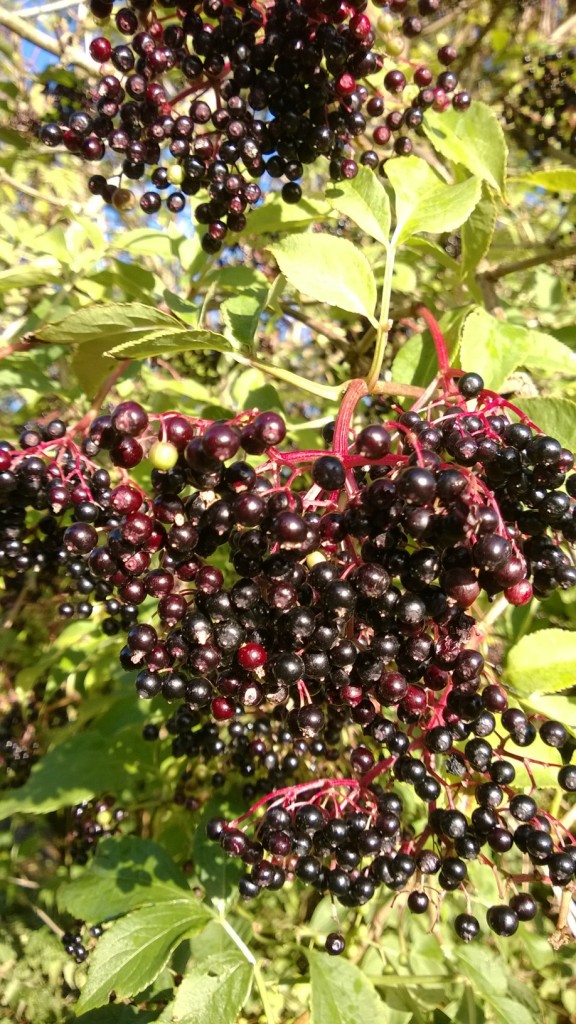

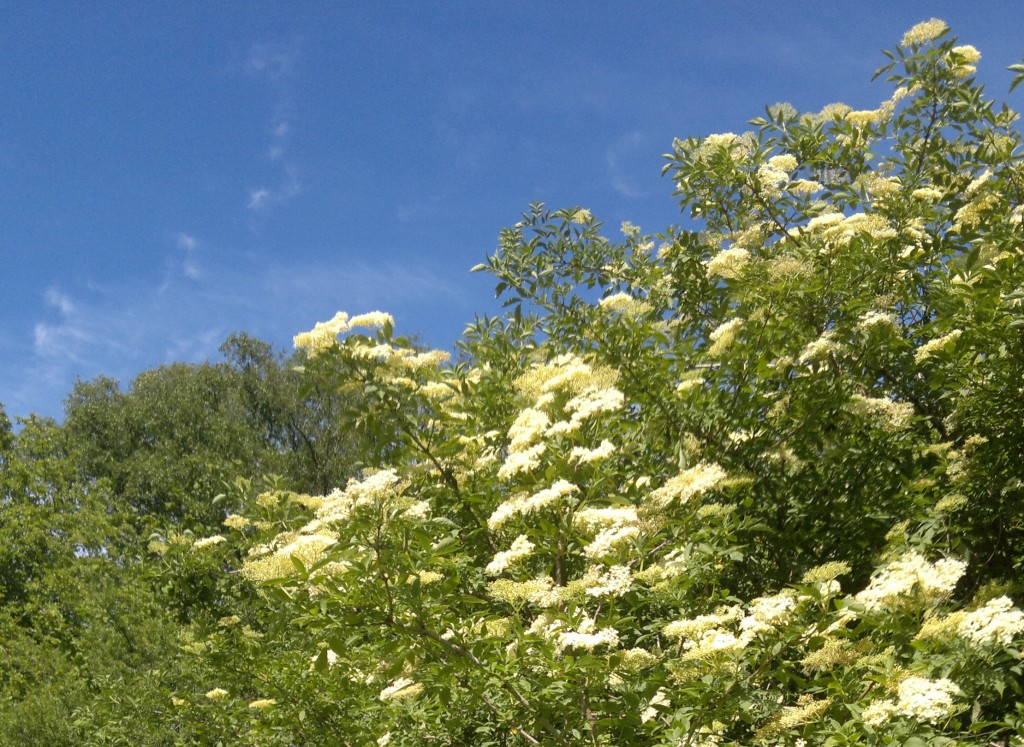
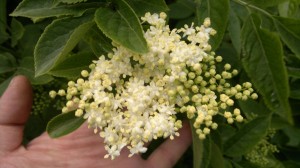

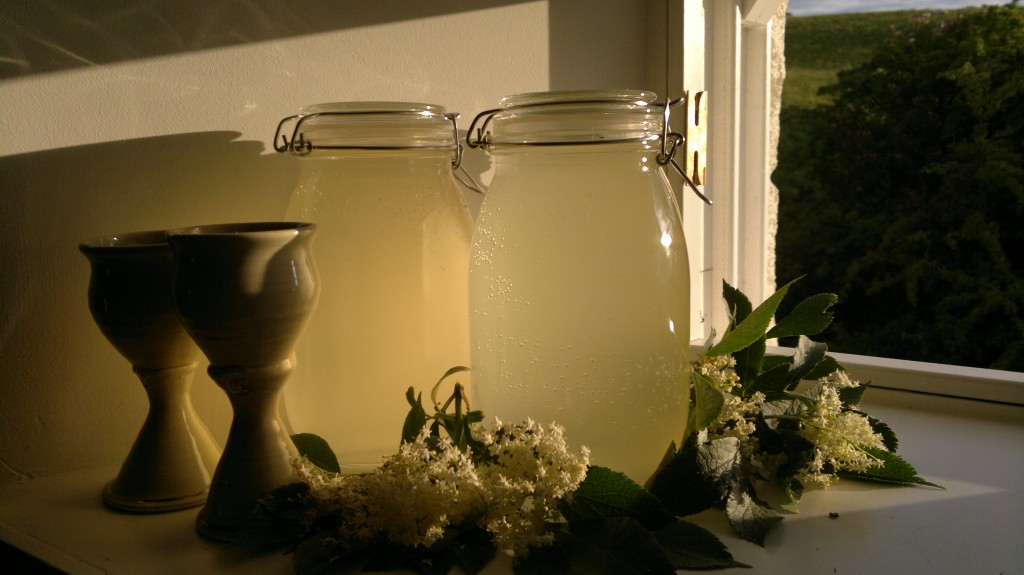
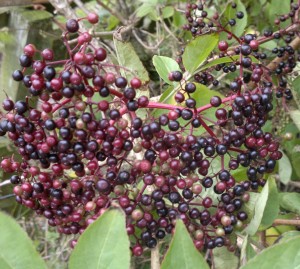
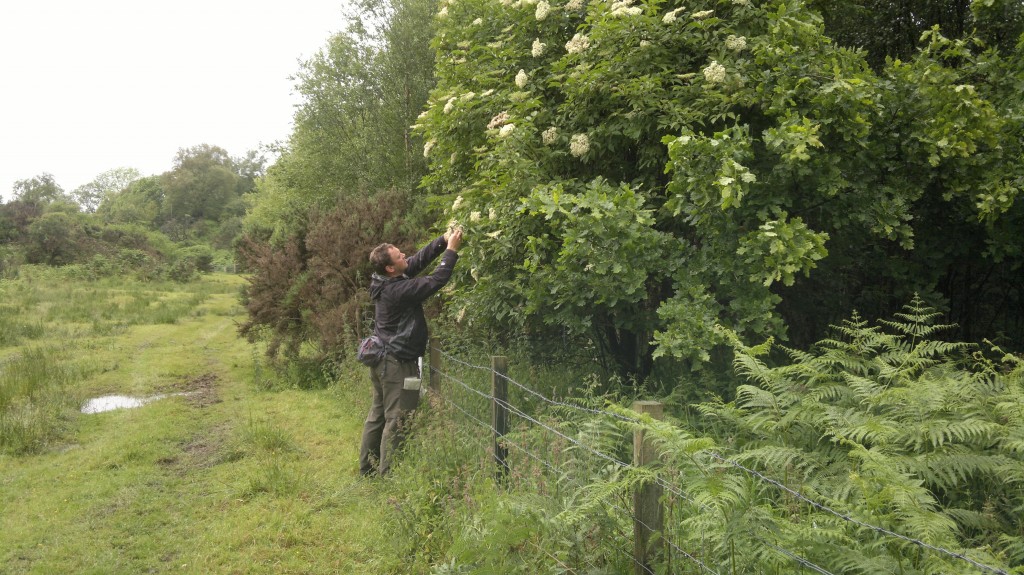
18 Comments
Hello,
Thank you for your informative site. I am wondering if you know of any parks or places around Glasgow or not too far that there are elderberry trees from which one can legally forage berries.
thank you!
Hi Cindy,
I’m glad you like the website.
I haven’t been to any park in Glasgow where there aren’t any elder trees. You can forage them legally. Just pick with consideration for other (human and non-human!) species that might appreciate them. On all but the smallest of trees you will be unlikely to be able to reach much more than a quarter of the fruits anyway, so I wouldn’t worry too much. Its easy to give a little back too, by planting a few elder twigs in wild corners – they grow quite readily. You’ll need to wait for next autumn now though…
Happy foraging,
Mark.
Hi. Don’t know if you’ve had answers yet but Cathcart Cemetary, Pollok Park anywhere in one of the public parks of our city is fine.
I left the stalls on when making elderflower cordial after one day I sieved everything out to add the sugar
Will it be safe to drink now as it was 24 hrs before o realised tc not cut off all the stalk ends
Hi,
I have just bought a Sambucus racemosa ‘Sutherland Gold’ at a reputable garden centre, but am a bit confused as I thought that the flowers came out in flat round bunches, but the information leaflet I obtained from the garden centre says they are small conical head of creamy-white flowers, followed by glossy red berries – can you advise me if the flowerheads can be used in making elderflower cordial and if the berries are a source of food for the birds.
Many thanks
Hi Pauline, Sorry, you are asking the wrong person – i’m OK with wild stuff, but not very up on the world of gardening and cultivars! But if it is definitely a variant of elder I can’t see why it can’t be used in the same ways.
Hi Mark,
I know this question has been around for about 2 years… just wanted to point out that Sambucus racemosa grows wild, too, at least it does in Switzerland. The berries can be cooked (make a nice jam), but the seeds need to be removed as they‘re poisonous. Don‘t eat the berries raw either. I haven‘t found anything about the flowers, but they do smell nice (not a criteria, I know).
Anne
Hi Mark,
Thanks so much for putting so much into your site! It’s my go-to now for all things will + foraging!!
Can I ask about the elder berries, are the purple/darker ones ripe or is it a different variety than the green?
Cheers
Michael
Hi, thanks. The darker, the riper. 🙂
Do you know if it’s possible to be allergic to the elder flower but not the berries ??
Yes, i’m sure that is possible. I get hay fever from the flowers.
I am thinking of buying my son a sambucus nigra golden tower. Do you know whether ground elder could develop from this tree? I am plagued with ground elder in my garden so naturally I wouldn’t want this to happen.
Ground elder is not related to elder trees/bushes. It only shares the name as it has a similar leaf structure to regular elder trees.
Found what I think is wild elderflowers today but they are not in one bush/tree rather in small plants dotted over and area or along the roadside. This is on the north coast of Scotland and they are just coming into flower, I’d love to either take cuttings or transplant, do you think this would be possible and is this variety edible.
Thank you
Take care! There are lots of plants with umbels of white flowers – many in the carrot/Apiaceae family. Some of these are very poisonous, other delicious – but some clear and focussed ID work is required. Your description does not sound like elder. See here:
Mark
I have a 4-year old elderberry tree and after the beautiful flowers came and went Im left with dark hard berries in June. Do I let these ripen to become juice-filled berries or is this the right stage now to pick and process into syrup? The birds are quickly feasting on them and I wonder if I need to net them till ripened
June sounds early for elderberries – but I don’t know where in the world you are. They are usually soft and ready by the time they are dark purple. Birds will always take their share if allowed!
Hi my mom evidently got two different types of elderberry plants. She has passed so I can’t ask her. One plant ripened about 2 weeks earlier than the other. The later one the birds ate all the ripe berries. The earlier one they haven’t touched. Should I be worried that the earlier elderberry isn’t an elderberry plant? She would have ordered from a reputable company.